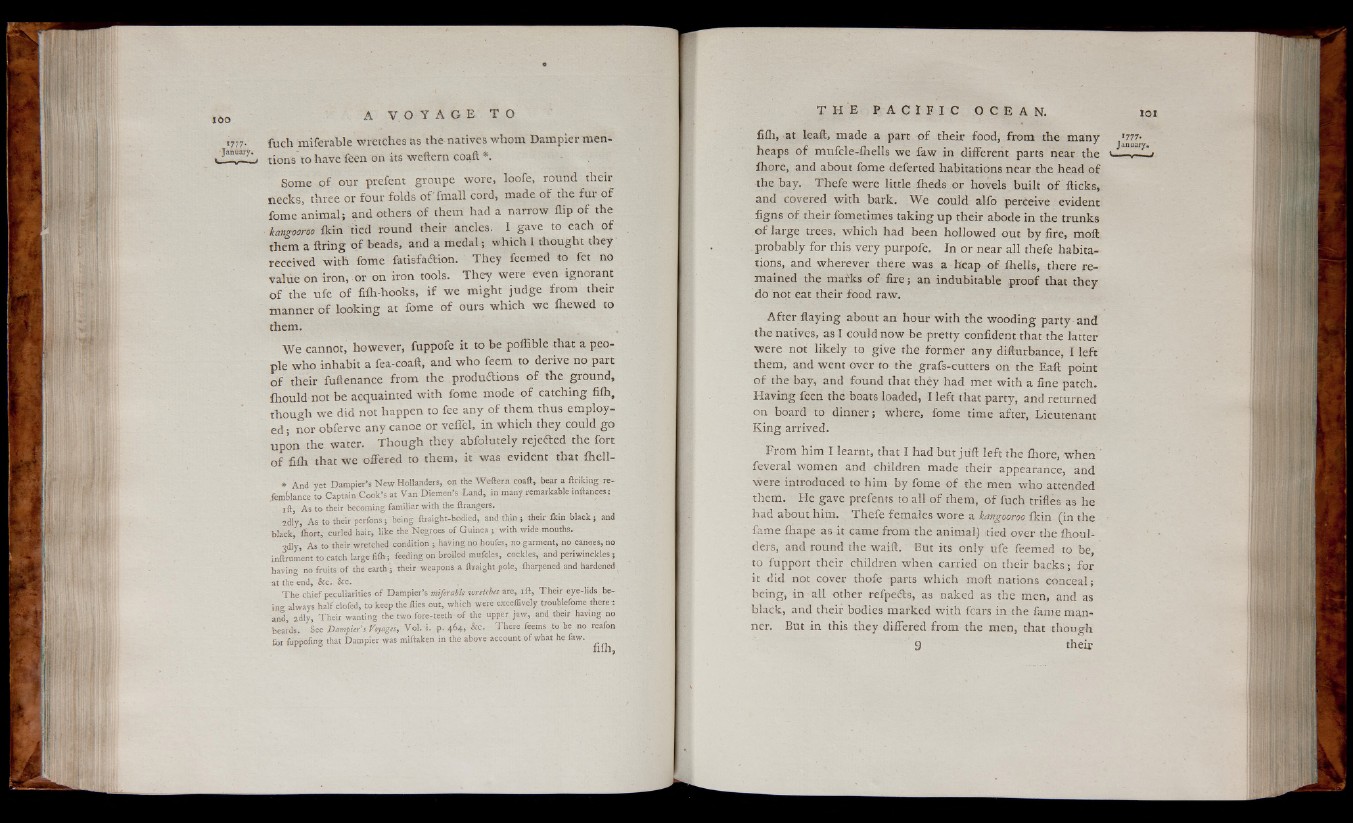
«777- fuch miferable wretches as the-natives whom Dampier men-
v. J‘ . tions to have feen on its weftem coaft *.
Some of our prefent groupe wore, loofe, round their
necks, three or four folds of’fmall cord, made of the fui o f
fome animal; and others of them had a narrow flip of the
kangooroo ikin tied round their ancles. 1 gave to each of
them a firing of beads, and a medal; which I thought they
received with fome fatisfacftion. They feemed to fet no
value on iron, or on iron tools. They were even ignorant
of the ufe of fifh-hooks, if we might judge from their
manner of looking at fome of ours which we lhewed to
them.
We cannot, however, fuppofe it to be pofiible that a people
who inhabit a fea-coaft, and who feem to derive no part
of their fuftenance from the produ&ions of the ground,
ihould not be acquainted with fome mode of catching fiih,
though we did not happen to fee any of them thus employed
; nor obferve any canoe or veffel, in which they could go
upon the water. Though they abfolutely rejefled the fort
of fiih that we offered to them, it was evident that ihell-
* And yet Dampier’ s New Hollanders, on the Weftern coaft, bear a linking re-
.femfflance to Captain Cook’s at Van Diemen’s Land, in many remarkable inllances:
i l l , As to their becoming familiar with the ftrangers.
2dly, As to their perfons ; being ftraight-bodied, and thin ; their ikin black; and
black, Ihort, carled hair, like the Negroes of Guinea ; with wide mouths.
3dly, As to their wretched condition ; having no houfes, no garment, no canoes, no
inftrttment to catch large fiih; feeding on broiled mufcles, cockles, and periwinckles ;
having no fruits of the earth ; their weapons a ftraight pole, iharpened and hardened
at the end, &c. &c.
The chief peculiarities of Dampier’s miferable wretches are, lit , Their eye-lids be-
ing always half clofed, to keep the flies out, which were exceffively troublefome there :
and, 2dly, Their wanting the two fore-teeth of the upper jaw, and their having no
beards. See Dampierls Voyages, Vol. i. p. 464, &c. There feems to be no reafon
for fuppofmg that Dampier was miflaken in the above account of what he few.
. fiih,
fiih, at leaft, made a part o f their food, from the many 1777-
heaps of mufcle-fliells we faw in different parts near the * . 17
ihore, and about fome deferted habitations near the head of
the bay. Thefe were little iheds or hovels built of flicks,
and covered with bark. We could alfo perceive evident
figns of their fometimes taking up their abode in the trunks
o f large trees, which had been hollowed out by fire, moft
probably for this very purpofe. In or near all thefe habitations,
and wherever there was a heap o f ihells, there remained
the maiks of fire; an indubitable proof that they
do not eat their food raw.
After flaying about an hour with the wooding party and
the natives, as I could now be pretty confident that the latter
were not likely to give the former any difturbance, I left
them, and went over to the grafs-cutters on the Eaft point
of the bay, and found that they had met with a fine patch.
Having feen the boats loaded, I left that party, and returned
on board to dinner; where, fome time after, Lieutenant
King arrived.
From him I learnt, that I had but juff left the Ihore, when
feveral women and children made their appearance, and
were introduced to him by fome of the men who attended
them. He gave prefents to all of them, of fuch trifles as he
had about him* Thefe females wore a kangooroo ikin fin the
fame ihape as it came from the animal) tied over the ihoul-
ders, and round the waift. But its only ufe feemed to be,
to fupport their children when carried on their backs; for
it did not cover thofe parts which moft nations conceal;
being, in all other refpetfts, as naked as the men, and as
black, and their bodies marked with fears in the fame manner.
But in this they differed from the men, that though
9 their